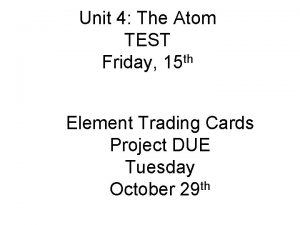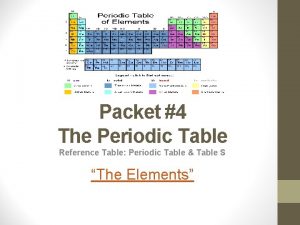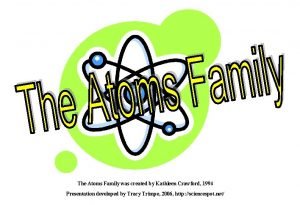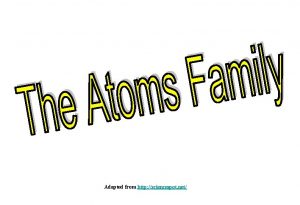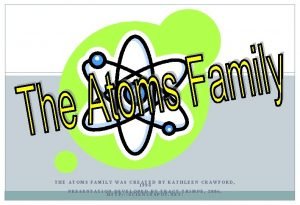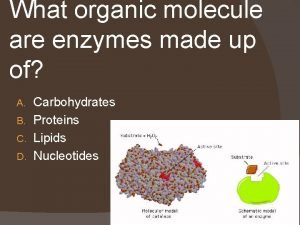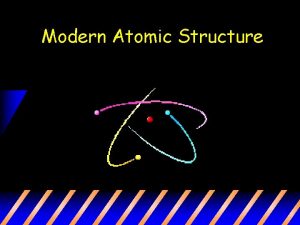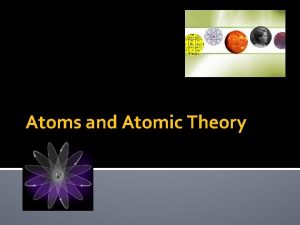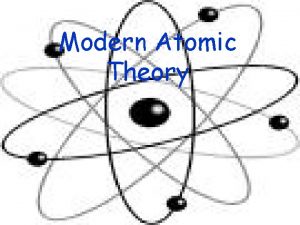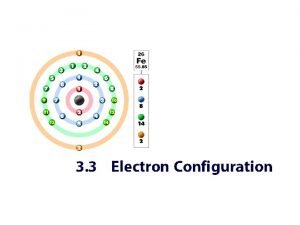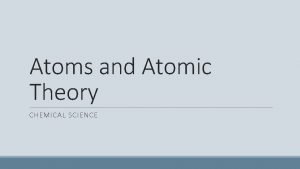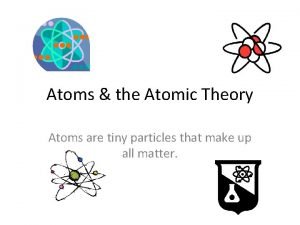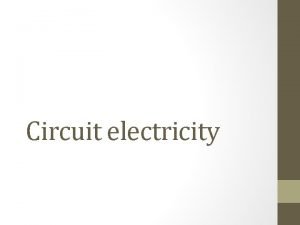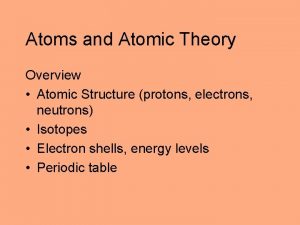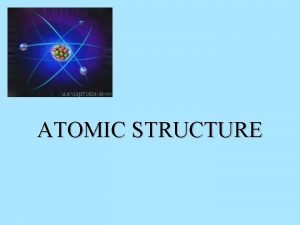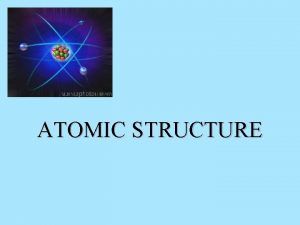3 Atomic Theory Atomic Theory Atoms are composed

















- Slides: 17

3. Atomic Theory

Atomic Theory ● Atoms are composed of three kinds of subatomic particles. The charges of these particles differ. PROTON I am positive! +1 ELECTRON NEUTRON I am negative! -1 I don’t care. I am neutral. 0

Atomic Models ● Atomic models try to show the relationship of the three subatomic particles and how they influence the physical and chemical properties of atoms. ● These models have been modified over the years as new information about the subatomic particles was learned (electrons do not orbit about the nucleus as thought in the early 1900 s). ● The current accepted model is the quantum mechanical model. first models developed most recent model

Atomic Models Questions to think about before watching this video: 1. 2. 3. 4. What is inaccurate about some models of the atom? How has our understanding of atoms developed over time? If electrons do not orbit the nucleus what do they do? What are two things we cannot know at the same time about electrons?

Structure of the Atom ● The number of protons is called the atomic number (this is how elements are ordered in the periodic table. ) ● The number of protons = number of electrons. ● Protons, electrons, and neutrons differ in their size and location. ● The protons + neutrons = mass of an atom. ● The electrons do not contribute to mass but are responsible for how elements chemically react with each other and how compounds are formed. Subatomic Particle Symbol Location in atom Relative Charge Relative Mass proton p+ in nucleus +1 1 neutron n 0 in nucleus 0 1 electron e- in energy levels outside nucleus -1 1/2000

Structure of the Atom An atom is mostly EMPTY SPACE! If an atom were the size of a stadium, the nucleus would be the size of an ant sitting in the centre of it.

The Bohr Model ● The atomic nucleus is located in the center of the atom. It contains the protons and neutrons. ● The electrons are located outside of the nucleus. They are arranged in different energy levels or energy shells. Shells are not physical structures but indicators of the amount of energy an electron has and how close to the nucleus it is most of the time. They are also NOT pathways that the electrons follow. ● The outermost electrons are the valence electrons. These are the ones involved in chemical reactions and bonding. The purpose of modelling is to help understand what is happening with these electrons during reactions and bonding. nucleus valence electron energy levels (or shells)

Drawing Bohr Models video ● Use Xs rather than dots and write them in pairs to reflect that electrons are organized in pairs in the atom. ● Some teachers will require that the number of neutrons is included in the nucleus on the diagram. ● Begin filling the inner most energy level with electrons and work towards the valence shell. ● Fill each energy level with the maximum number of electrons that it can hold (2, 8, 8, 18) and then move to the next outer one. ● Unless it is a noble gas, the outer valence level will not be full. Also some electrons should be unpaired in the valence level. energy level 4 (empty) energy level 3 2 e- (valence) energy level 2 8 e- (max) energy level 1 2 e- (max) nucleus 12 p+ Mg Bohr diagram for Mg

Drawing Modified Bohr Diagrams Atomic number 11; 2 + 8+ ? = 11 electrons Maximum electrons energy level 1→ 2 e. Atomic number 12 (Mg) energy level 2→ 8 eenergy level 3→ 8 eenergy level 4→ 18 e- valence electrons 12 p+ 2 e- 8 e- 2 e-

Can you find the pattern? Bohr Diagram Worksheet - Individual Work Draw modified Bohr diagrams for the first 20 elements to see if there is a periodic table pattern in: a) number of valence electrons b) number of energy levels

Yet another model… Lewis Diagrams ● Lewis diagrams only show the valence electrons as dots or Xs around the elemental symbol. These diagrams are useful to help understand how elements bond. You will examine bonding in Grade 11 chemistry. Bohr diagram for chlorine Lewis diagram for chlorine

Putting it all together… valence electrons and the periodic table.

Practice Drawing Models Practice worksheet

The Periodic Table ● The periodic table is a special organization of elements by their atomic number (the number of protons). ● There have been many periodic tables developed, but the most popular one was developed by Dmitri Mendeleev. ● Mendeleev's periodic table effectively arranged atoms in a way that revealed many patterns in properties of atoms and allowed amazing predictions.

Think Like Mendeleev Activity

Patterns in the periodic table The repeating patterns in atomic structure result in many other patterns seen in the periodic table. These include patterns in size and properties, boiling points, density and chemical reactivity. Atomic Size

Patterns in the periodic table Graphing Skills: Trends in Periodic Table worksheet
 Antigentest åre
Antigentest åre Regents periodic table
Regents periodic table Matterville answer key
Matterville answer key Reference table of atomic radii
Reference table of atomic radii The atoms family atomic math challenge
The atoms family atomic math challenge Http sciencespot net
Http sciencespot net The atoms family atomic math challenge
The atoms family atomic math challenge Matterville answer key
Matterville answer key Is atomic mass and relative atomic mass the same
Is atomic mass and relative atomic mass the same Patterns of the periodic table
Patterns of the periodic table What is atomic radius
What is atomic radius O
O Difference between atomic number and atomic mass
Difference between atomic number and atomic mass Atomic number vs atomic radius
Atomic number vs atomic radius The lowest allowable energy state of an atom
The lowest allowable energy state of an atom Electrons in atoms section 2 quantum theory and the atom
Electrons in atoms section 2 quantum theory and the atom Quantum theory and the electronic structure of atoms
Quantum theory and the electronic structure of atoms Enzymes are composed of what organic molecule
Enzymes are composed of what organic molecule


